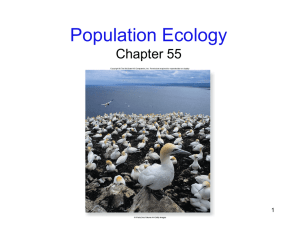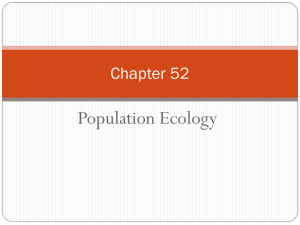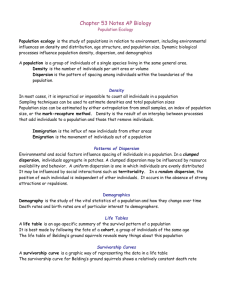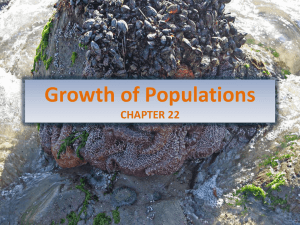Chapter 53: Population Ecology is the study of populations in
advertisement
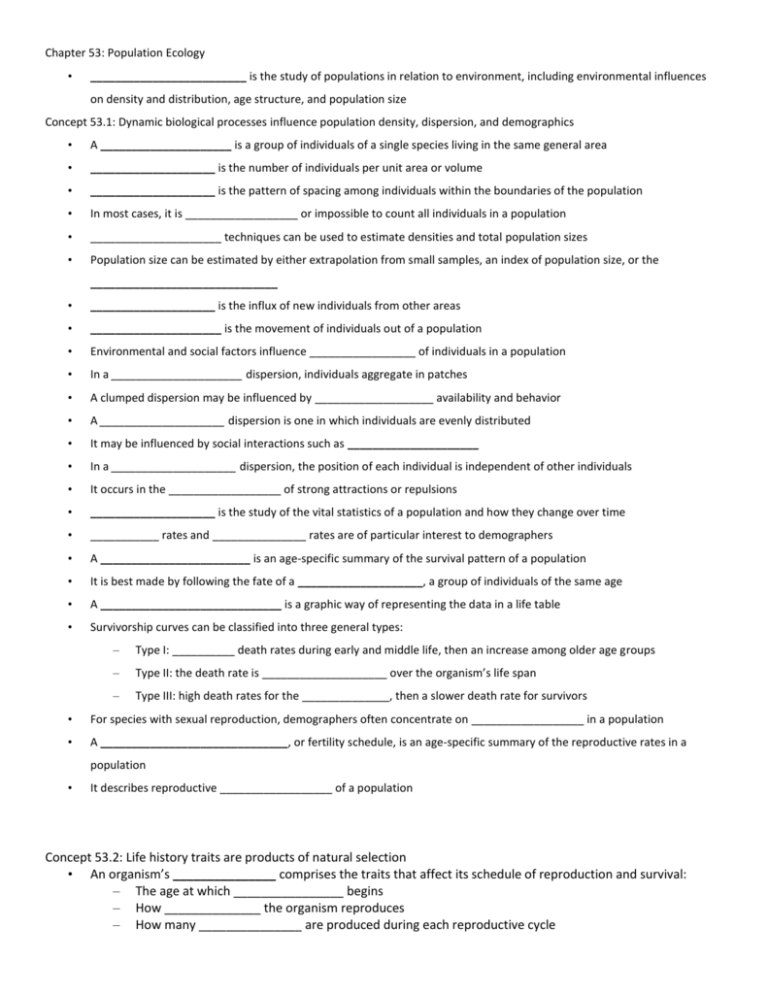
Chapter 53: Population Ecology • _________________________ is the study of populations in relation to environment, including environmental influences on density and distribution, age structure, and population size Concept 53.1: Dynamic biological processes influence population density, dispersion, and demographics • A _____________________ is a group of individuals of a single species living in the same general area • ____________________ is the number of individuals per unit area or volume • ____________________ is the pattern of spacing among individuals within the boundaries of the population • In most cases, it is __________________ or impossible to count all individuals in a population • _____________________ techniques can be used to estimate densities and total population sizes • Population size can be estimated by either extrapolation from small samples, an index of population size, or the ______________________________ • ____________________ is the influx of new individuals from other areas • _____________________ is the movement of individuals out of a population • Environmental and social factors influence _________________ of individuals in a population • In a _____________________ dispersion, individuals aggregate in patches • A clumped dispersion may be influenced by ___________________ availability and behavior • A ____________________ dispersion is one in which individuals are evenly distributed • It may be influenced by social interactions such as _____________________ • In a ____________________ dispersion, the position of each individual is independent of other individuals • It occurs in the __________________ of strong attractions or repulsions • ____________________ is the study of the vital statistics of a population and how they change over time • ___________ rates and _______________ rates are of particular interest to demographers • A ________________________ is an age-specific summary of the survival pattern of a population • It is best made by following the fate of a ____________________, a group of individuals of the same age • A _____________________________ is a graphic way of representing the data in a life table • Survivorship curves can be classified into three general types: – Type I: __________ death rates during early and middle life, then an increase among older age groups – Type II: the death rate is ____________________ over the organism’s life span – Type III: high death rates for the ______________, then a slower death rate for survivors • For species with sexual reproduction, demographers often concentrate on __________________ in a population • A ______________________________, or fertility schedule, is an age-specific summary of the reproductive rates in a population • It describes reproductive __________________ of a population Concept 53.2: Life history traits are products of natural selection • An organism’s _______________ comprises the traits that affect its schedule of reproduction and survival: – The age at which ________________ begins – How ______________ the organism reproduces – How many _______________ are produced during each reproductive cycle • • • • Life histories are very ________________ Species that exhibit semelparity, or ________________ reproduction, reproduce once and die Species that exhibit iteroparity, or _______________ reproduction, produce offspring repeatedly Highly variable or ___________________ environments likely favor big-bang reproduction, while ________________ environments may favor repeated reproduction • Organisms have ______________ resources, which may lead to trade-offs between survival and reproduction • Some plants produce a large number of small seeds, ensuring that at least some of them will grow and eventually _______________ • Other types of plants produce a ______________ number of large seeds that provide a large store of energy that will help seedlings become established • In animals, _______________ care of smaller broods may facilitate survival of offspring Concept 53.3: The exponential model describes population growth in an idealized, unlimited environment • It is useful to study population growth in an _____________ situation • Idealized situations help us understand the capacity of species to increase and the _______________ that may facilitate this growth • If immigration and emigration are ignored, a population’s growth rate (per capita increase) equals __________ rate minus ______________ rate • _______________________________ occurs when the birth rate equals the death rate • _________________ population growth is population increase under idealized conditions • Under these conditions, the rate of reproduction is at its ____________ • Exponential population growth results in a _______________ curve • The J-shaped curve of exponential growth characterizes some _____________________ populations Concept 53.4: The logistic model describes how a population grows more slowly as it nears its ____________ capacity • Exponential growth cannot be _______________ for long in any population • A more realistic population model ____________ growth by incorporating carrying capacity • ______________________ (K) is the maximum population size the environment can support • In the __________________ population growth model, the per capita rate of increase declines as carrying capacity is reached • The logistic model of population growth produces a sigmoid (_______________) curve • Some populations ________________ K before settling down to a relatively stable density • Some populations ___________________ greatly and make it difficult to define K • Some populations show an _________________ effect, in which individuals have a more difficult time surviving or reproducing if the population size is too small • ____-selection, or density-dependent selection, selects for life history traits that are sensitive to population density • ____-selection, or density-independent selection, selects for life history traits that maximize reproduction Concept 53.5: Many factors that regulate population growth are density dependent • There are two general questions about regulation of population growth: – What environmental factors stop a population from growing indefinitely? – Why do some populations show radical fluctuations in size over time, while others remain stable? • In __________________ populations, birth rate and death rate do not change with population density • In _____________________ populations, birth rates fall and death rates rise with population density • Density-dependent birth and death rates are an example of ______________ feedback that regulates population growth • They are affected by many factors, such as _____________ for resources, territoriality, disease, predation, toxic wastes, and intrinsic factors • In _________________ populations, increasing population density intensifies competition for resources and results in a lower birth rate • In many vertebrates and some invertebrates, competition for _______________ may limit density • Population density can influence the ___________ and survival of organisms • In dense populations, ______________ can spread more rapidly • As a prey population builds up, predators may feed _______________ on that species • Accumulation of ___________ wastes can contribute to density-dependent regulation of population size • • For some populations, _____________ (physiological) factors appear to regulate population size The study of ________________ focuses on the complex interactions between biotic and abiotic factors that cause variation in population size • Long-term population studies have challenged the hypothesis that populations of large mammals are relatively __________________ over time • ___________________ can affect population size over time • Changes in _______________ pressure can drive population fluctuations • Some populations undergo regular ___________________ cycles • __________________ are groups of populations linked by immigration and emigration • High levels of immigration combined with higher survival can result in greater ______________ in populations Concept 53.6: The _______________ population is no longer growing exponentially but is still increasing rapidly • No population can grow __________________, and humans are no exception • The human population increased relatively slowly until about ________________ and then began to grow exponentially • Though the global population is still growing, the rate of growth began to ___________ during the 1960s • To maintain population stability, a regional human population can exist in one of two configurations: – Zero population growth = High birth rate – High death rate – Zero population growth = Low birth rate – Low death rate • The ________________________ is associated with an increase in the quality of health care and improved access to education, especially for women • Most of the current global population growth is concentrated in ______________ countries • One important demographic factor in present and future growth trends is a country’s ________________ • Age structure is the relative number of individuals at each ________ • Age structure diagrams can predict a __________________ growth trends • They can illuminate social conditions and help us plan for the ____________ • _____________ mortality and _______________________ at birth vary greatly among developed and developing countries but do not capture the wide range of the human condition • The carrying capacity of Earth for humans is _______________ • The average estimate is 10–15 _____________ • The ____________________ footprint concept summarizes the aggregate land and water area needed to sustain the people of a nation • It is one _________________ of how close we are to the carrying capacity of Earth • ___________________ vary greatly in footprint size and available ecological capacity • Our carrying capacity could potentially be limited by __________, _______________, nonrenewable resources, or buildup of _______________


